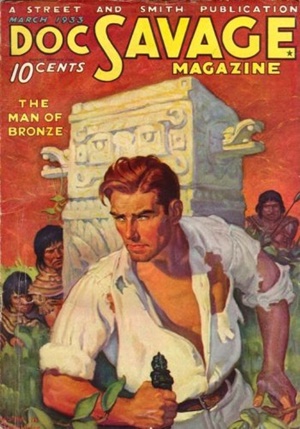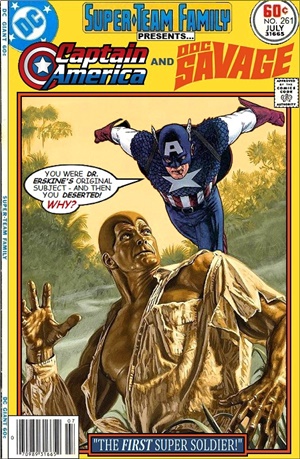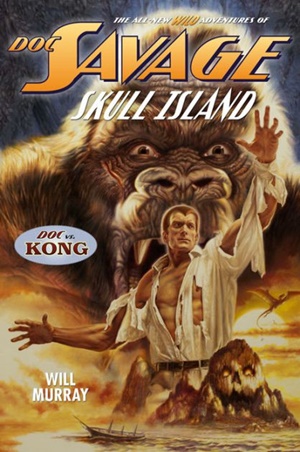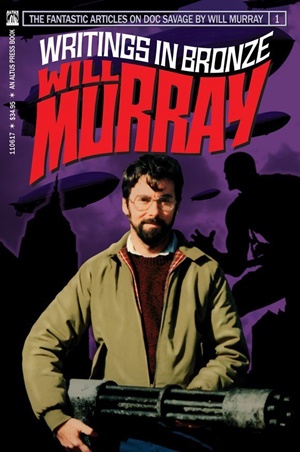A (Black) Gat in the Hand – II: Will Murray on Doc Savage
 “You’re the second guy I’ve met within hours who seems to think a gat in the hand means a world by the tail.” – Phillip Marlowe in Raymond Chandler’s The Big Sleep
“You’re the second guy I’ve met within hours who seems to think a gat in the hand means a world by the tail.” – Phillip Marlowe in Raymond Chandler’s The Big Sleep
(Gat — Prohibition Era term for a gun. Shortened version of Gatling Gun)
Back in June, I posted that A (Black) Gat in the Hand was returning this summer. Last year, from May 14th through December 31st, every Monday morning featured a new hardboiled/pulp-related post – mostly by me, but with several friends who wrote some great stuff. I love hardboiled/PI stories and I’m as proud of that series as I am of the two Robert E. Howard ones I’ve helped coordinate here at Black Gate.
So, I called on some more friends this year, and I sought out some wider-ranging topics – the pulp magazines were FAR more than just mystery and detective-based. The Adventure Pulps were the dominant ones for years, with exciting tales of derring do and discovery. Even today, Doc Savage remains the best-known name among adventure heroes. And Will Murray, who is currently writing authorized Doc Savage novels (plus a LOT more), kicks off our series with a look at the Man of Bronze.
DOC FRANKENSTEIN
Doc Savage was not created so much as he was assembled in much the way Victor Frankenstein stitched together his infamous monster from unconnected charnel parts.
The year was 1932. At the Street & Smith publishing company, they had a surprise runaway success in a magazine called The Shadow. Inspired by a creepy radio voice used to promote their Detective Story Magazine, the mockingly laughing Shadow captured America’s imagination in that dark Depression year. The magazine kept selling out. S&S pushed author Walter B. Gibson into producing two novels a month so they could release the pulp periodical every other week. The Shadow Magazine kept selling.
Street & Smith business manager and informal editorial director Henry W. Ralston, who had been with the firm since the days of their long-running dime novel heroes, Nick Carter and Frank Merriwell, sensed that the public might be ready for another generational hero.
Since The Shadow dominated the mystery-thriller field, Ralston believed that the adventure genre was ripe for revival. All he needed was a hero.
 Ralston had once met a dashing former military officer and lawyer, a jack of all trades who had built bridges all over the world and served as a diplomat and possibly even a spy for the United States government. From time to time, this remarkable individual wrote books, one of which became a bestseller. Street & Smith had published him in those long-ago days.
Ralston had once met a dashing former military officer and lawyer, a jack of all trades who had built bridges all over the world and served as a diplomat and possibly even a spy for the United States government. From time to time, this remarkable individual wrote books, one of which became a bestseller. Street & Smith had published him in those long-ago days.
His name was Richard Henry Savage, and he became the template on which Ralston and others would graft pieces of other heroes, both real and fictitious.
From the company’s own archives, Ralston borrowed the idea that had spawned Nick Carter, that of a daring young man who was raised by his father to be the greatest detective who ever lived. Nick pre-dated Sherlock Holmes by one year and had proven just as successful as Conan Doyle’s legendary creation, spawning literally thousands of sequels.
So Doc Savage was conceived as having been raised by a far-sighted father to be a consummate master of all skills, trades and sciences, the Supreme Adventurer in Ralston’s own words. And like Nick Carter a generation before him, Doc Savage’s public career would be launched by the murder of his male parent.
Ralston came up with the name, using the dime novel formulation of naming a character after his chief attributes. Doc was a surgeon––the greatest in the world––and his nickname would symbolize his brilliant genius. As for Savage, that would stand for his powerful physical development, a byproduct of a youth of intensive physical training, for the elder Savage had placed young Clark into the hands of innumerable scientists and other experts at a very early age, the better to prepare him for his heroic and adventurous life.
Ralston shared his concept over lunch at Gallagher’s steakhouse with a young editor named John Leonard Nanovic, who helped guide and develop The Shadow. Even as the nation kept sinking deeper into economic peril, The Shadow Magazine remained a countervailing circulation success.
Both men understood that no matter how well they developed their new concept, they would need a competent writer to breathe life into him.
Enter Lester Dent. Three years before, he had been a telegraph operator in Tulsa, Oklahoma, and broke into print via Street & Smith’s pulp magazines. Dent had subsequently moved on to other houses, but someone at S&S remembered his vivid prose and electrifying if eccentric stories.
Editor-in-chief Frank Blackwell reached out to Dent, only to discover that he had relocated to New York City. A meeting was arranged, during which Blackwell offered the 28-year-old pulpster a Shadow novel to write. It was a test to see if he could be groomed to write Doc Savage, then a nameless proposition still in a formative stage of development.
Dent turned in his Shadow novel that summer, but not much happened until the Fall. The economy continued to falter. If do-nothing Herbert Hoover was reelected President, matters might not improve. No sooner had Franklin Roosevelt beat him than long-deferred plans to launch Doc Savage Magazine were reactivated.
Sensing that the election of the Democratic president would lead to a more optimistic American public, they called in Dent, who knocked out the initial Doc novel, The Man of Bronze, in two weeks flat just before Christmas. The first issue of Doc Savage Magazine hits the stands in the middle of February, 1933. It ran sixteen years.
Decades later, when it was all over with, Ralston recalled of Doc Savage:
“We grabbed him right out of thin air. We made him a surgeon and scientist, because we wanted him to know chemistry, philosophy, and all that stuff. We also made him immensely wealthy––he’d inherited a huge fortune from his father. He crusaded against crime of all kinds––plots against the United States, against industry, against society at large. He was very strong physically, a giant man to bronze with eyes whose pupils resembled pools of flake gold, always in gentle motion. You might say he was the poor man’s Monte Christo.”
Lester Dent put it this way.
“Well, in looking about for a character for all these stories I was going to write I looked at what people had gone for already. So I took Sherlock Holmes, with his deducting ability, Tarzan of the Apes, with his towering physique and muscular ability, Craig Kennedy with his scientific knowledge, and Abraham Lincoln with his Christliness. Then I rolled ’em all into one to get—Doc Savage.”
 But more went into Doc Savage than that honor roll of classic characters. From an earlier Street & Smith pulp hero, Erle Stanley Gardner’s human fly named Speed Dash, they borrowed the conceit of a protagonist who did daily exercises which imbued him with fantastic physical and mental skills, including the ability to climb brick buildings by finger-strength alone.
But more went into Doc Savage than that honor roll of classic characters. From an earlier Street & Smith pulp hero, Erle Stanley Gardner’s human fly named Speed Dash, they borrowed the conceit of a protagonist who did daily exercises which imbued him with fantastic physical and mental skills, including the ability to climb brick buildings by finger-strength alone.
Street & Smith had also been publishing stories of a South Seas Tarzan named Kroom, whose ability to hold his breath underwater was prodigious. This trait was also grafted onto Doc Savage.
Doc’s signature trilling vocalization was meant to mirror The Shadow’s equally uncanny laugh, but its origins stemmed from Max Brand’s Whistling Dan Barry and his peculiar whistle. Barry was another S&S character. The trilling’s subconscious nature was lifted from the protagonist in E. C. Bentley’s 1913 detective novel, Trent’s Last Case.
The top box office star of 1933 was Clark Gable, a former Tulsa oil field worker and, one suspects, another of Lester Dent’s inspirations. So they named the new hero Clark and initially instructed artists to make Doc resemble Gable, but without the mustache. This directive was soon abandoned.
Doc had as secret source of gold, which emanated from a lost Mayan city, much like Tarzan’s gold, which came from the Atlantean colony of Opar deep in darkest Africa. During the summer before starting Doc Savage, Dent visited the reclusive Death Valley Scotty, who claimed to own a secret gold mine, which was guarded by Shoshone Indians. A hero who operated on a global scale needed to be very, very rich.
Dent’s favorite magazine, Argosy, had been running a popular series starring an American adventurer named Peter the Brazen, sometimes called the Man of Bronze. Lester appropriated that descriptive label. Where Tarzan was called a “bronzed giant,” Dent would described his metallic hero as a “bronze giant.”
Finally, Doc Savage was painted as a paragon of virtue, the better to inspire young readers to emulate his Boy Scout lifestyle, and assure parents that Doc Savage Magazine represented good, clean reading. That had been a non-negotiable hallmark of all Street & Smith series since the days of Nick Carter, whose father had enjoined him to “Keep your mind, your body and your conscience clean.”
Around Doc was assembled a group of experts, much like new President Frankin D. Roosevelt’s vaunted “Brain Trust.” Except that these were fighting men who happened to be tops in their lines in chemistry, engineering, the law and other useful fields.
Upon his debut, Doc Savage was presented as a New Deal superman, perfectly in tune with Roosevelt’s vision for the future of the Depression-beleagured nation. He was a quantum leap ahead of any hero fictional who had come before. Lester Dent probably considered him to be a tall tale writ larger than usual. Groping for an appropriate way to promote him, editor John Nanovic dubbed Doc a “super-hero.”
“I didn’t realize how many people wanted to be Superman,” Dent recalled in 1945. “It’s more clear to me now. A man comes in from driving a taxi all day to find his wife threatening to throw him out on his ear for not bringing home more tips to turn over to her. Naturally, he wants to be a Superman. Or a barber who had to vegetate in his shop all day, don’t you reckon he yearns for a chance to get out and re-order the life of whole continents? Doc is the what-I-would-like-to-be dream of everybody, including me.”
Doc Savage was read avidly by the Depression generation. The decade of the 1930s was not yet over when some maturing Doc fans began producing comic-strip knockoffs of the Man of Bronze, beginning with Superman, who borrowed Doc’s first name of Clark, his distinctive spitcurl, and ultimately appropriated his Fortress of Solitude, right down to the exclusive address in the North Pole.
 Once the Man of Steel and the superheroes who sprang up in his wake began outselling Doc Savage Magazine, Lester Dent took notice. He was neither pleased nor flattered by these supercharged imitations, complaining to an interviewer, “After the flood of super-people, phantoms, bat-men and such people that Doc started coming out of the cartoonists’ and writers’ ink-wells, my stomach kind of turned…And remember, I didn’t have Doc brought from another planet the way Superman was, I just had Doc reared and trained by scientists, that’s all.”
Once the Man of Steel and the superheroes who sprang up in his wake began outselling Doc Savage Magazine, Lester Dent took notice. He was neither pleased nor flattered by these supercharged imitations, complaining to an interviewer, “After the flood of super-people, phantoms, bat-men and such people that Doc started coming out of the cartoonists’ and writers’ ink-wells, my stomach kind of turned…And remember, I didn’t have Doc brought from another planet the way Superman was, I just had Doc reared and trained by scientists, that’s all.”
Ironically, Doc became one of the building blocks for the first generation of superheroes. The creators of Batman and Superman all acknowledged his influence. Superman literally purloined Doc’s Arctic Fortress of Solitude while Batman grabbed his utility belt and gadgets. Several lesser Golden Age superheroes were obvious knockoffs, Doc Strange the most prominent among them.
Genetically, Doc Savage elements are present in popular culture icons such as Challengers of the Unknown, The Fantastic Four, The X-Men, James Bond, The Man from U.N.C.L.E., Star Trek’s Mr. Spock, Buckaroo Banzai and Clive Cussler’s Dirk Pitt, as well as lesser comic book knockoffs such as Doc Brass, Tom Strong, Mr. Braunze, Marvel’s Doc Samson and a reimagining of Frankenstein’s Monster as a pulp hero calling himself—wait for it––Doc Frankenstein. And then there are the pastiche versions of the character, Doc Wildman, Doc Wilde, Doc Caliban, Doc Sidhe, and others not necessarily named Doc.
One of Dent’s ghostwriters, Ryerson Johnson, remembered Lester saying, “Doc Savage looks human, acts human, but he’s just a slightly little bit more. Not enough to make him freakish. It takes delicate handling….”
While Doc sometimes displayed traits that pushed the limits of peak human performance, such as the ability to dodge a speeding bullet or see in the dark, he fell short of possessing superpowers as we understand them today. Readers of that era might not have accepted such a quantum leap ahead in human potential.
As Johnson observed, “The business of trying to be fresh in every story, trying to find new ways to describe the faintly-more-than-human power, was a hoodoo.”
One would think such a Frankenstein patchwork of a character would disintegrate under the weight of his borrowed traits, but no. Writing as Kenneth Robeson, Lester Dent and his ghost writers imbued his golden-eyed Golem with a convincing half-life that carried the series from the start of the Great Depression to the dawn of the Cold War in 1949. Doc Savage sales rivaled that of The Shadow, and when Bantam Books revived him in the 1960s, millions of copies were sold until all 181 original novels were back in print. Then new stories were commissioned, beginning with one by noted science fiction writer Philip Jose Farmer.
Deep into the 21st century, new Doc Savage novels continue to be written. But unlike his superheroic contemporaries such as Superman and Batman––many of whom he inspired––Doc Savage still operates in the 1930s, where his fans seem to prefer him. I’ve been privileged to continue his epic adventures, working from Lester Dent’s notes, outlines and unfinished manuscripts keeping Doc in period and sometimes squealing classic tales. The Wild Adventures of Doc Savage has also broken new ground, pitting him against King Kong in Skull Island, teaming him up with his dark counterpart, The Shadow, in The Sinister Shadow and Empire of Doom, as well as giving his adventurous cousin Patrica a stand-alone novel of her own, Six Scarlet Scorpions. You can find them all on Amazon or on our website, www.adventuresinbronze.com, also with our Tarzan, King Kong and Spider novels.
Prior posts in A (Black) Gat in the Hand (Series 2)
Back Deck Pulp Returns
A (Black) Gat in the Hand Returns
A (Black) Gat in the Hand – 2018
With a (Black) Gat: George Harmon Coxe
With a (Black) Gat: Raoul Whitfield
With a (Black) Gat: Some Hard Boiled Anthologies
With a (Black) Gat: Frederick Nebel’s Donahue
A (Black) Gat in the Hand: Thomas Walsh
A (Black) Gat in the Hand: Black Mask – January, 1935
A (Black) Gat in the hand: Norbert Davis’ Ben Shaley
A (Black) Gat in the Hand: D.L. Champion’s Rex Sackler
A (Black) Gat in the Hand: Dime Detective – August, 1939
A (Black) Gat in the Hand: Back Deck Pulp #1
A (Black) Gat in the Hand: W.T. Ballard’s Bill Lennox
A (Black) Gat in the Hand: Day Keene
A (Black) Gat in the Hand: Black Mask – October, 1933
A (Black) Gat in the Hand: Back Deck Pulp #2
A (Black) Gat in the Hand: Black Mask – Spring, 2017
A (Black) Gat in the Hand: Frank Schildiner’s ‘Max Allen Collins & The Hard Boiled Hero’
A (Black) Gat in the Hand: William Campbell Gault
A (Black) Gat in the Hand: More Cool & Lam From Hard Case Crime
A (Black) Gat in the Hand: MORE Cool & Lam!!!!
A (Black) Gat in the Hand: Thomas Parker’s ‘They Shoot Horses, Don’t They?’
A (Black) Gat in the Hand: Joe Bonadonna’s ‘Hardboiled Film Noir’ (Part One)
A (Black) Gat in the Hand: Joe Bonadonna’s ‘Hardboiled Film Noir’ (Part Two)
A (Black) Gat in the Hand: William Patrick Maynard’s ‘The Yellow Peril’
A (Black) Gat in the Hand: Andrew P Salmon’s ‘Frederick C. Davis’
A (Black) Gat in the Hand: Rory Gallagher’s ‘Continental Op’
A (Black) Gat in the Hand: Back Deck Pulp #3
A (Black) Gat in the Hand: Back Deck Pulp #4
A (Black) Gat in the Hand: Back Deck Pulp #5
A (Black) Gat in the Hand: Joe ‘Cap’ Shaw on Writing
A (Black) Gat in Hand: Back Deck Pulp #6
A (Black) Gat in the Hand: The Black Mask Dinner
There are some outstanding names in the ‘New Pulp’ field, but William Patrick Murray’s probably stands above them all. Along with Doc Savage, Will has written Tarzan and The Shadow. Short stories, comic books, radio plays, nonfiction essays and books – Murray has done it all. His collection of essays on Doc Savage, Writings in Bronze, is a must read. I love a good book introduction, and Murray has written some fine ones for Altus Press. Visit Adventures in Bronze.
 Bob Byrne’s ‘A (Black) Gat in the Hand’ was a regular Monday morning hardboiled pulp column from May through December, 2018.
Bob Byrne’s ‘A (Black) Gat in the Hand’ was a regular Monday morning hardboiled pulp column from May through December, 2018.
His ‘The Public Life of Sherlock Holmes’ column ran every Monday morning at Black Gate from March, 2014 through March, 2017 (still making an occasional return appearance!).
He organized ‘Hither Came Conan,’ as well as Black Gate’s award-nominated ‘Discovering Robert E. Howard’ series.
He is a member of the Praed Street Irregulars, founded www.SolarPons.com (the only website dedicated to the ‘Sherlock Holmes of Praed Street’) and blogs about Holmes and other mystery matters at Almost Holmes.
He has contributed stories to The MX Book of New Sherlock Holmes Stories – Parts III, IV, V and VI.
And he contributed to The New Adventures of Solar Pons.
I read a ton of Bama-covered Doc Savage paperbacks when I was an adolescent. Now, every few years I’ll pick one up again, and a chapter or two in I remember – these things are nothing but PLOT. No atmosphere, no non-cardboard characters, no incidental pleasures – just PLOT. They’re still fun in their way, but my memory of the last one has to completely fade before I’m reckless enough to take up another.
So…it’s about time!
Thomas – I read a dozen or so of the Bantam (I think) paperbacks when I was in high school/college. I liked them, but didn’t go back to the series.
I’ve always wanted to, but other things pressed for my attention.
I’ve been reading some Dirk Pitt and Kurt Austin, and Gabriel Hunt stories, to do a post on them as Doc’s successors.
Hello I’m Kevin yoka and a big fan of doc savage I was hoping you could halp me find a link the source where Henry w ralston says talks about doc savage inspirations including a source to where he says : “We grabbed him right out of thin air. We made him a surgeon and scientist, because we wanted him to know chemistry, philosophy, and all that stuff. We also made him immensely wealthy––he’d inherited a huge fortune from his father. He crusaded against crime of all kinds––plots against the United States, against industry, against society at large. He was very strong physically, a giant man to bronze with eyes whose pupils resembled pools of flake gold, always in gentle motion. You might say he was the poor man’s Monte Christo.” please I’d love to have access to the full conversation
As smart and wealthy as Doc was you’d think he’d have his shirts tailored to have more room around the arms.
I was not aware that attempts for a Doc Savage movie, starring Dwayne ‘The Rock’ Johnson, and helmed by Shane Black (who I have a lot of trust in), first kicked around about three years ago.
I’d like to see that combo get a chance at the character.
A great overview of a seminal pulp character from the person best equipped to provide it. Another coup for this ongoing series, Bob. A welcome return, indeed. – Bill
Bill – I think I first started after Will three years ago, to write a Doc Savage post for BG, but as you know, he’s busy beyond busy. But he had told me, when he could fit it in, he’d like to writ one.
I was excited to get his essay one day. I knew A Black Gat… was coming back, so he agreed to let me hold it for the series.
We’ve got some more excellent guest posters on board already (still room for you!!), including James Reasoner and Duane Spurlock, on western pulp. That’s a topic I REALLY wanted to include this time. I’m hoping to add a piece on an REH western that has a Hammett vibe to it.
once I get back on top of ‘life’ after last week’s hernia surgery, I’ll get this series “out there” more.
[…] Savage (Black Gate): Doc Savage was not created so much as he was assembled in much the way Victor Frankenstein […]
[…] Savage (Black Gate): Doc Savage was not created so much as he was assembled in much the way Victor Frankenstein […]
[…] comics blog Smash Pages has a new interview with Will Murray, mostly on Doc Savage. Black Gate has Will Murray on Doc Savage. I hadn’t realised he had published a 455-page Writings in Bronze ebook on Doc Savage in […]